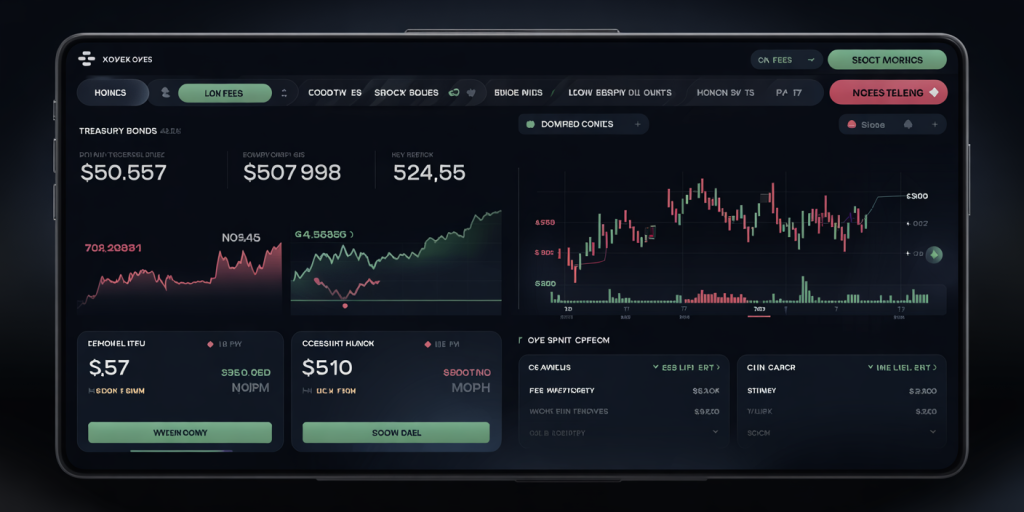Best Platforms to Invest in Treasury Bonds and Stocks
Anúncios
Investing in treasury bonds and stocks has become increasingly accessible due to the rise of digital platforms that facilitate direct market participation for everyday investors. Whether you’re a seasoned trader or a newcomer, selecting the right platform is crucial to managing your portfolio effectively. Treasury bonds offer the stability of government-backed securities, while stocks provide opportunities for growth through equity ownership. This comprehensive guide explores the best platforms available today to invest in these financial instruments, backed by data, practical examples, and user-centric features.
Understanding the Investment Landscape: Treasury Bonds vs Stocks
Anúncios
Before delving into platform specifics, it’s important to understand the fundamental differences between treasury bonds and stocks, as well as their respective roles in a diversified investment portfolio. Treasury bonds are long-term government securities typically considered low-risk, paying periodic interest to investors. Stocks, on the other hand, represent ownership shares in companies and offer variable returns that depend on market performance and company growth.
For example, during market volatility such as the 2020 COVID-19 pandemic selloff, treasury bonds were regarded as safe havens, offering steady returns while stocks experienced steep declines. According to the U.S. Department of the Treasury, 10-year Treasury bond yields hovered around 0.9% in early 2021, providing a reliable source of income amid uncertainty. Conversely, stocks like those in the S&P 500 showed high volatility but also delivered substantial rebound gains by year-end.
Choosing an investment platform that caters to both assets allows investors to balance risk and reward efficiently. The platforms explored here emphasize ease of access to treasury bonds and stocks, transparency in fees, and robust trading or purchasing tools.
Leading Platforms for Treasury Bond Investments
Investing in treasury bonds requires a platform that provides seamless access to government securities with minimal cost and hassle. Among the top contenders, TreasuryDirect, Fidelity, and Charles Schwab stand out for their functionality and user experience.
TreasuryDirect is the official U.S. government platform designed specifically for buying treasury securities including Treasury bills, notes, and bonds. This platform charges no commission fees and offers direct ownership without intermediary costs. For retail investors looking to purchase $100 or more in treasury bonds, TreasuryDirect provides an unparalleled no-fee, straightforward experience. However, the interface can be less intuitive compared to commercial brokers.
Fidelity is a leading brokerage known for its broad investment offerings and competitive pricing. With Fidelity, investors gain access to treasury bonds in both primary and secondary markets. Moreover, Fidelity provides detailed research tools, bond laddering strategies, and automatic reinvestment options for interest payments. The platform’s robust mobile app and 24/7 customer service add convenience and confidence for users managing their bond holdings.
Charles Schwab combines low-cost investing with strong educational resources. Schwab’s bond desk offers extensive treasury securities trading with transparent pricing—typically no markup on bonds. Investors can place bond orders online or speak to Schwab representatives for assistance in building diversified bond portfolios. Additionally, Schwab’s bond portfolio analytics help investors monitor market risks and yields.
| Platform | Fees | Access to Primary Market | Secondary Market Access | Mobile Experience | Customer Support |
|---|---|---|---|---|---|
| TreasuryDirect | No fees | Yes | No | Basic web-based | Email/Phone |
| Fidelity | No commission on bonds | Yes | Yes | Excellent | 24/7 Phone & Chat |
| Charles Schwab | No markups on bonds | Yes | Yes | Very good | Phone & In-person |
These platforms illustrate the trade-offs between minimal fees, ease of use, and support for treasury bond investors.
Top Platforms for Stock Investing
For investors focusing on stocks, choosing a platform that combines low trading costs, comprehensive market access, and advanced analytical tools is key. The three most notable platforms for stock trading today are Robinhood, E*TRADE, and TD Ameritrade.
Robinhood revolutionized stock investing by offering commission-free trades and a user-friendly mobile-first approach. With over 22 million users as of 2023, Robinhood appeals especially to younger investors entering the stock market. The platform enables the trading of stocks, ETFs, options, and even cryptocurrencies. While it lacks some advanced research tools available on other platforms, Robinhood’s simplicity facilitates quick transactions and fractional share investing.
E*TRADE is a mature brokerage platform that caters to both beginner and professional investors. Its wide array of tools for screening stocks, monitoring portfolios, and market news make it suitable for diverse investing strategies. E*TRADE offers zero commissions on online stock and ETF trades, plus extensive educational resources. The platform’s portfolio analysis and tax management features help investors optimize returns while minimizing liabilities.
TD Ameritrade (now part of Charles Schwab) is renowned for its Thinkorswim desktop platform, which provides powerful charting and technical analysis capabilities prized by active traders. TD Ameritrade supports commission-free stock and ETF trades, with a wealth of research reports from top providers like Morningstar and CFRA. The stock screener and option strategy tools also enhance decision-making for equity investors.
| Platform | Commission Fees | Stock Trading Tools | Fractional Shares | Educational Resources | Mobile/ Desktop Apps |
|---|---|---|---|---|---|
| Robinhood | $0 | Basic | Yes | Limited | Mobile-focused |
| E*TRADE | $0 | Advanced & User friendly | No | Extensive | Strong Mobile/Desktop |
| TD Ameritrade | $0 | Professional-grade | No | Comprehensive | Excellent Mobile/Desktop |
These popular platforms exemplify how stock investing can be tailored from novice to expert levels.
Practical Examples of Platform Usage
To illustrate how these platforms serve different investor needs, consider two hypothetical scenarios:
Scenario 1: Jane, a conservative retiree looking for steady income Jane wants to allocate a significant portion of her portfolio to treasury bonds for safety. She uses TreasuryDirect to buy long-term Treasury bonds directly, avoiding fees. To diversify, she also opens a Fidelity account to purchase short-term notes and monitors interest rate risks through Fidelity’s analytics. Jane appreciates Fidelity’s customer support when questions arise regarding bond maturity and reinvestment options.
Scenario 2: Mark, a millennial interested in active stock trading Mark uses Robinhood for quick, commission-free trades in tech stocks and ETFs, experimenting with fractional shares to diversify his limited capital. For research purposes, he supplements Robinhood with TD Ameritrade’s Thinkorswim to analyze stock trends and options strategies before executing trades. This dual-platform approach ensures he balances convenience and advanced analytics.
These cases demonstrate the benefits of employing multiple platforms tailored to distinct investment goals rather than using a one-size-fits-all approach.
Fee Structures and Security Considerations
An essential factor in selecting an investment platform is understanding the fee structure, as costs can substantially affect net returns over time. TreasuryDirect is unique in offering zero commissions or account maintenance fees, which benefits fixed-income investors dealing in smaller denominations. Conversely, some brokerages may charge nominal transaction fees for bond purchases or markups in secondary markets.
For stock platforms, the industry standard has shifted towards zero-commission trades for stocks and ETFs. However, investors should be cautious of hidden costs such as payment for order flow (PFOF) arrangements, margin loan interest rates, or inactivity fees. For instance, Robinhood generates significant revenue via PFOF, which some critics argue may result in less favorable trade executions.
Security and regulatory compliance are paramount. All the platforms discussed adhere to U.S. Securities and Exchange Commission (SEC) and Financial Industry Regulatory Authority (FINRA) regulations. Additionally, customer funds and securities are protected by the Securities Investor Protection Corporation (SIPC) up to $500,000. TreasuryDirect is backed directly by the U.S. Department of the Treasury, ensuring a unique level of security for bondholders.
Future Perspectives: Evolving Investment Platforms and Trends
The investment platform landscape continues to evolve rapidly with advancements in technology and changing investor preferences shaping future developments. Artificial intelligence (AI) and machine learning are increasingly integrated to provide personalized investment advice, risk assessments, and automated portfolio management, often termed “robo-advisors.”

Platforms like Fidelity and Charles Schwab have already incorporated AI-driven tools that suggest bond ladders or equity allocations based on real-time market conditions and individual risk profiles. Likewise, blockchain-based platforms are emerging to offer tokenized bonds and fractional stock ownership with enhanced transparency and liquidity.
Another trend is the democratization of access through fractional share investing, expanding participation to lower-income investors. Robinhood popularized this concept for stocks, while platforms are beginning to apply similar models for treasury bonds and mutual funds.
Sustainability-focused investing is another area gaining traction, with platforms integrating environmental, social, and governance (ESG) metrics into stock screening and bond issuance. Investors increasingly seek platforms that allow them to align portfolios with their values without sacrificing returns.
In conclusion, choosing the best platform for investing in treasury bonds and stocks depends on factors such as investment goals, cost sensitivity, and desired features. TreasuryDirect, Fidelity, and Charles Schwab offer robust solutions for bond investors, while Robinhood, E*TRADE, and TD Ameritrade lead in stock investing options. As platforms innovate and blend traditional securities with emerging technologies, investors stand to benefit from more efficient, accessible, and tailored investment experiences.


